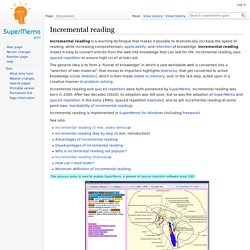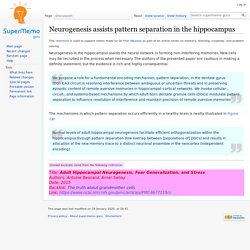

SuperMemo.com. True history The popular history of spaced repetition is full of myths and falsehoods.

This text is to tell you the true story. The problem with spaced repetition is that it became too popular for its own effective replication. Like a fast mutating virus it keeps jumping from application to application, and tells its own story while accumulating errors on the way. Who invented spaced repetition? This is the story of how I solved the problem of forgetting. Back in the early 1990s, I thought I knew how to turn education systems around the world upside down and make them work for all students.
To root SuperMemo in science, we made a major effort to publish our ideas in a peer-review journal, adopted a little known scientific term of " spaced repetition " and set our learning technology in a context of learning theory and the history of research in psychology. If you read SuperMemopedia here you may conclude that "Nobody should ever take credit for discovering spaced repetition". Credits. SuperMemo.com. The speed of learning will depend on the way you formulate the material.

The same material can be learned many times faster if well formulated! The difference in speed can be stunning! The rules are listed in the order of importance. Those listed first are most often violated or bring most benefit if complied with! There is an underlying assumption that you will proceed with learning using spaced repetition, i.e. you will not just learn once but you will repeat the material optimally (as in SuperMemo). You might want to experiment and try to learn two subjects using the two above approaches and see for yourself what advantage is brought by minimum information principle. Note in the example above how short the questions are. You will notice that the knowledge learned in the ill-structured example is not entirely equivalent to the well-structured formulation.
Learn fast and forget about forgetting. Incremental reading - supermemo.guru. Incremental reading is a learning technique that makes it possible to dramatically increase the speed of reading, while increasing comprehension, applicability, and retention of knowledge.

Incremental reading makes it easy to convert articles from the web into knowledge that can last for life. Incremental reading uses spaced repetition to ensure high recall at low cost. The general idea is to form a "funnel of knowledge" in which a vast worldwide web is converted into a "selection of own material", that moves to important highlights (extracts), that get converted to active knowledge (cloze deletion), which is then made stable in memory, and, in the last step, acted upon in a creative manner in problem solving. Incremental reading and spaced repetition were both pioneered by SuperMemo. SuperMemo.com. This text was taken from P.A.Wozniak, Optimization of learning, Master's Thesis, University of Technology in Poznan, 1990 and adapted for publishing as an independent article on the web.

(P.A.Wozniak, June 4, 1998).For a more up-to-date texts on the same subject see: In reference to molecular memory review: Molecular interpretation of mechanisms of memory underlying the optimum spacing of repetitions from P.A.Wozniak, Economics of learning, Doctoral Thesis, University of Economics in Wroclaw, 1995. Artificial intelligence needs to sleep - supermemo.guru.
This article by Dr Piotr Wozniak is part of SuperMemo Guru series on memory, learning, creativity, and problem solving.

Artificial intelligence kept meandering. It was always a great hope, but we used to be blind to the limitations of our models. We thought we could program AI. We thought neural networks are a solution. We can now build fantastic tools with specialist skills, and still struggle to put a truly universally intelligent system together. We kept underappreciating a few design principles that are used by the human brain. Some things AI needs to learn from the brain: AI cannot just rely on pattern recognition and feats of combinatorial computation: The brain needs to actively hunt for quality knowledge, store it coherently for long-term use, optimize knowledge for higher intelligence, and engage in a deductive-exploratory loop in problem solving Jeff Hawkins is doing great trying to mimic the neocortex.
For high intelligence, the learn drive must be autonomous. Neurogenesis assists pattern separation in the hippocampus - supermemo.guru. This reference is used to support claims made by Dr Piotr Wozniak as part of an article series on memory, learning, creativity, and problem solving.

Neurogenesis in the hippocampus assists the neural network in forming non-interfering memories. New cells may be recruited in the process when necessary. The authors of the presented paper are cautious in making a definite statement, but the evidence is rich and highly consequential. We propose a role for a fundamental encoding mechanism, pattern separation, in the dentate gyrus (DG)–CA3 circuit in resolving interference between ambiguous or uncertain threats and in preserving episodic content of remote aversive memories in hippocampal–cortical networks.
We invoke cellular-, circuit-, and systems-based mechanisms by which adult-born dentate granule cells (DGCs) modulate pattern separation to influence resolution of interference and maintain precision of remote aversive memories Quoted excerpts come from the following reference: Senecalearning. Reading.
Ruminating. Etudes. Entutelage. Invigorating. Libraria. Robust.